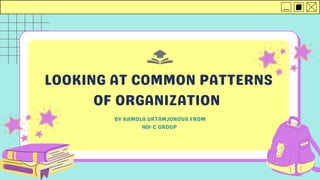
Looking at common patterns of Organization
- 1. LOOKING AT COMMON PATTERNS OF ORGANIZATION BY KAMOLA UKTAMJONOVA FROM 401-C GROUP
- 2. Text structures, or patterns of organization, not only vary from writing to writing, but text structures may also change frequently from paragraph to paragraph within a single piece of writing. Though not all text can fit snugly into one of the patterns of organizations explained in this website, the purpose of this website is to prepare students to identify text structure on standardized tests. Though requirements vary from state to state, in many states, students are required to accurately identify the text structure in specific passages. We will cover eight common types of patterns of organizations or text structures: 1. Chronological pattern 5. Advantage-disadvantage pattern 2. Sequential pattern 6. Cause and effect pattern 3. Spatial pattern 7. Problem-solution pattern 4. Compare-contrast pattern 8. Topical pattern Patterns of organization
- 3. A chronological pattern of organization arranges information according to a progression of time, either forward or backward. When a topic is best understood in terms of different segments of time, a chronological format works well. For example, topics of an historical nature are best organized using this pattern. When using a chronological pattern, each main section of information represents a particular period of time, and the sub-points contained within each main section refer to significant events that occurred within that time frame. A variation of this organizational pattern involves dividing a topic into "past-present-future" or" before-during-after" segments. Chronological pattern
- 4. Sequential Patterns A sequential pattern of organization is similar to a chronological pattern, but arranges information according to a step-by-step sequence that describes a particular process. Using a sequential pattern, each main section of information represents a main step that one would follow in the actual process. The points included within each main section represent the sub-steps one would follow. When one wishes to describe a process that follows a specific series of steps in a particular order, then, a sequential pattern works well.
- 5. Spatial Patterns A spatial pattern of organization arranges information according to how things fit together in physical space; i.e., where one thing exists in relation to another. This pattern works well when a writer wishes to create a mental picture of something which has various parts distinguished by physical location. Topics involving geography, for example, are often best organized using a spatial pattern
- 6. Compare-Contrast Patterns A compare and contrast pattern arranges information according to how two or more things are similar to or different from one another (or both). This is an effective pattern to use when the reader can better understand one subject when it is described in relation to another. If the reader is familiar with one topic, the writer can compare or contrast it with another topic to shed insight on it.
- 7. Advantages-Disadvantages Patterns This pattern organizes information about a topic by dividing it up into its "good" and "bad" parts, or pro's and con's. It is effective to use when a writer wishes to objectively discuss both sides of an issue without taking a persuasive stance. This allows the reader to weigh both sides of an issue. As with the compare-contrast pattern, there are a number of possible variations to an advantages-disadvantages pattern. The simplest form of this pattern is shown below.
- 8. This pattern is used to show the different causes and effects of various conditions. This pattern is particularly effective when writing a persuasive document in which the writer advocates some action to solve a problem, because it demonstrates important relationships between variables. There are two major variations to this pattern; (a) dividing the outline into two major sections comprised of causes and effects; or (b) dividing the outline according to the different causes, with the effects of each cause contained within the larger "causes" section. See the example below. Cause-Effect Patterns
- 9. Problem-Solution Patterns A problem-solution pattern divides information into two main sections, one that describes a problem and one that describes a solution. This pattern is typically used in persuasive writing, where the writer's general purpose is to convince the reader to support a certain course of action. The pattern is designed to compel the reader to make some kind of change in opinion or behavior by establishing that a problem exists, then providing a solution. In the problem section, the writer identifies different aspects of the problem being discussed and offers evidence of these problems. In the solution section, the writer identifies a potential solution and supports the effectiveness of this solution over others.
- 10. Topical Pattern This pattern is the most commonly used format, and will typically work when the other patterns do not. A topical pattern arranges information according to different sub-topics within a larger topic, or the "types" of things that fall within a larger category. Using this pattern, each "type" represents a main section of information.